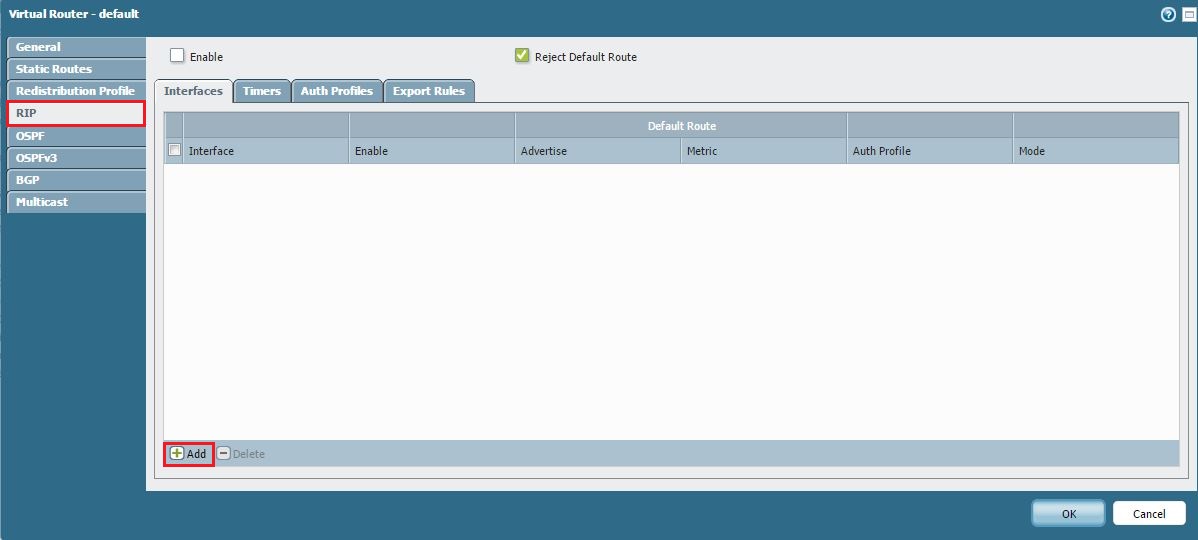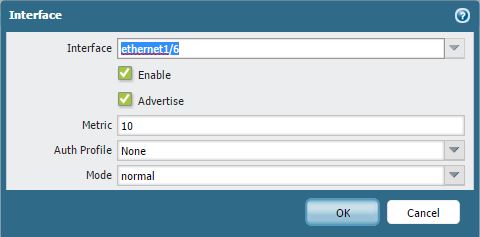Overview
This document describes how to configure Routing Information Protocol (RIP) on a Palo Alto Networks device.
Example scenario:

Steps
- Go to Network > Virtual Router and check default.

- Select RIP and add the interface to enable the protocol.

- Select the interface and check Enable and Advertise, as shown below.

- Enable the RIP protocol, as shown below.

- Follow the same steps for other Palo Alto Networks devices and check the neighbor state.
>show routing protocol rip peer
==========
virtual router: default
peer address: 13.0.0.1
last update: Wed Nov 5 01:52:54 2014
RIP version: 2
invalid packets: 0
invalid routes: 0
>show routing protocol rip summary
==========
virtual router: default
reject default route: yes
redist default route: block
interval seconds: 1
update intervals: 30
expire intervals: 180
delete intervals: 120
interface: 13.0.0.2
- Check routing table and RIP database table, as shown below.
>show routing protocol rip database
VIRTUAL ROUTER: default
==========
Flags: S:stale path, L:linked, P:programmed
destination metric tag flag path-detail
10.50.240.0/24 1 0 L RDIST connected route on ethernet1/1
10.50.240.0/24 2 0 LP RIP route, next hop 13.0.0.1, from peer 13.0.0.1,
ge 26
10.50.241.0/24 2 0 LP RIP route, next hop 13.0.0.1, from peer 13.0.0.1,
ge 26
10.50.242.0/24 1 0 L RDIST connected route on ethernet1/3
10.50.242.0/24 2 0 LP RIP route, next hop 13.0.0.1, from peer 13.0.0.1,
ge 26
12.0.0.0/24 2 0 LP RIP route, next hop 13.0.0.1, from peer 13.0.0.1,
ge 26
13.0.0.0/24 1 0 LP RIP connected route on ethernet1/6
13.0.0.0/24 1 0 L RDIST connected route on ethernet1/6
192.168.10.12/30 1 0 L RDIST route, next hop 192.168.10.12
192.168.10.16/30 1 0 L RDIST route, next hop 192.168.10.16
172.16.2.2/31 2 0 LP RIP route, next hop 13.0.0.1, from peer 13.0.0.1,
ge 26
172.16.2.4/31 2 0 LP RIP route, next hop 13.0.0.1, from peer 13.0.0.1,
ge 26
192.168.10.10/31 1 0 L RDIST route, next hop 192.168.10.10
192.168.10.20/32 1 0 L RDIST route, next hop 192.168.10.20
13.0.0.0/24 10 0 L RIP local route
>show routing route
flags: A:active, ?:loose, C:connect, H:host, S:static, ~:internal, R:rip, O:ospf,
:bgp,
Oi:ospf intra-area, Oo:ospf inter-area, O1:ospf ext-type-1, O2:ospf ext-type-2
VIRTUAL ROUTER: default (id 1)
==========
destination nexthop metric flags age interface
0.0.0.0/0 10.50.241.1 10 A S ethernet1/2
10.50.240.0/24 10.50.240.63 0 A C ethernet1/1
10.50.240.0/24 13.0.0.1 2 R ethernet1/6 << Route
learned through RIP
10.50.240.63/32 0.0.0.0 0 A H
10.50.241.0/24 13.0.0.1 2 A R ethernet1/6
10.50.241.63/32 0.0.0.0 0 A H
10.50.242.0/24 10.50.242.63 0 A C ethernet1/3
10.50.242.0/24 13.0.0.1 2 R ethernet1/6 << Route
learned through RIP
10.50.242.63/32 0.0.0.0 0 A H
12.0.0.0/24 13.0.0.1 2 A R ethernet1/6
13.0.0.0/24 0.0.0.0 1 R ethernet1/6 << Route
learned through RIP
13.0.0.0/24 13.0.0.2 0 A C ethernet1/6
13.0.0.2/32 0.0.0.0 0 A H
172.16.2.2/31 13.0.0.1 2 A R ethernet1/6
172.16.2.4/31 13.0.0.1 2 A R ethernet1/6
192.168.10.10/31 192.168.10.10 10 A S tunnel.4
192.168.10.12/30 192.168.10.12 10 A S tunnel.4
192.168.10.16/30 192.168.10.16 10 A S tunnel.4
192.168.10.20/32 192.168.10.20 10 A S tunnel.4
total routes shown: 19
Note: Palo Alto Networks devices support only RIPv2. Auto-summarization of RIP routes is not supported.
See Also
How to Configure RIP Authentication